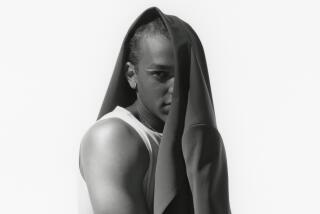Men girdle for a fashion battle
- Share via
NEW YORK — A man wearing a skirt may be the garment industry’s last taboo, the point at which fashion becomes a joke.
The intent of the new exhibition at the Metropolitan Museum of Art is not to squelch the laughter but rather to investigate why it bubbles up at all. “Bravehearts: Men in Skirts” runs through Feb. 8 in the museum’s Costume Institute. It is sponsored by the French designer Jean Paul Gaultier, who created his first skirt for gentlemen in 1984 and who has been the fashion industry’s most stubborn advocate of men escaping the tyranny of trousers.
Men, for the most part, do not realize that they are in fashion bondage.
Gaultier has taken on the role of the unwelcome liberator with an eye toward giving men the same flexibility in their wardrobe that women have long had. Contemporary cultural dress codes, Gaultier says, are unfair.
“Men can be masculine only if they are wearing trousers,” he says. By contrast, women can be feminine “not just by the way they are dressing.” With the addition of skirts, Gaultier believes, men can achieve a greater degree of visual complexity. Their fashion messages can be more nuanced, more thoughtful and more worldly. With the addition of skirts to a man’s wardrobe, the battle for equality between the sexes will be advanced. Masculinity will be more broadly defined.
To celebrate the opening of the exhibition, the Costume Institute hosted a cocktail party for which the dress code was business attire. But the word went out that in honor of the show’s topic, it would be nice if men were to wear skirts. Gents arrived in kilts and pareos, wrap skirts and caftans, miniskirts and even the kind of decorative smock dress that might be found on a Russian folk dancer.
Several gentlemen chose the long robes of designer Miguel Adrover, who has built his reputation on the combination of a traditional Middle Eastern caftan and a Western-style, tailored blazer. Kilts were the most popular choice of the evening.
One of the pressing questions of the evening was how a man accessorizes with a skirt. The favored footwear was the combat boot, a rough dose of masculinity to offset the sweet luxuriousness of several yards of fabric swishing around the legs.
Eddie Izzard arrived in a black leather miniskirt, fishnet tights and eye shadow. But he crossed the line from simply being a fellow in a skirt to being a man in drag. The exhibition’s vision of boy skirts is not one of men putting on the markers of femininity like costumes but rather of taking traditional feminine attire and making it theirs.
The best examples of the masculinization of skirts were offered by men such as actor Alan Cumming, who wore a pinstriped suit that was conservative and restrained except for the fact that his bottom was covered by a skirt. Gaultier wore a formal black evening suit with a beautifully cut blazer, a crisp white shirt and a matching black skirt that fell to his ankles. And the exhibition’s curator, Andrew Bolton, wore a moss-colored three-piece suit designed by Gaultier that consisted of a blazer, slim trousers and a coordinating kilt.
Bolton organized a smaller version of this exhibition in 2001 when he was on the staff of the Victoria and Albert Museum in London. From the beginning, his interest in men and skirts has been more intellectual than practical.
While riding the subway in London several years ago, he noticed a man, probably in his early 30s, dressed in what could have been a Savile Row tailored, pinstriped business suit, but with a skirt. The fellow, wearing braces and carrying a copy of the Financial Times, looked as though he might be headed to a brokerage house. He also had his girlfriend on his arm.
“All the typical labels couldn’t apply,” Bolton says. “It wasn’t a performance. It wasn’t in a subcultural context. You couldn’t place on him the label of being gay. He was completely conservative apart from the skirt. And it really challenged the stereotype of who wears a skirt.”
In assembling this show, Bolton considered historical situations in which the display of male legs was a sign of virility. He recalled the Scottish Highland warrior, the Roman gladiator and the Greek gods -- all are represented in the exhibition.
He put aside the strictures of Western culture and looked at how clothing demarcates gender around the world. He underscores how only in the West is the skirt assigned to women alone. Men wear sarongs in Southeast Asia, djellabas in the Middle East and caftans in Africa.
He looked to popular culture, where male rock stars such as Axl Rose and punk performers wear skirts, and the effect only heightens their image of macho and cool.
Bolton even suggests that skateboarders’ super-wide jeans and rappers’ baggy denim, with the crotch hanging to the knees, and their oversize shirts that fall even lower, reference dresses and skirts.
More to Read
The biggest entertainment stories
Get our big stories about Hollywood, film, television, music, arts, culture and more right in your inbox as soon as they publish.
You may occasionally receive promotional content from the Los Angeles Times.










